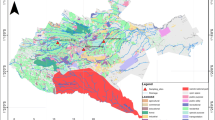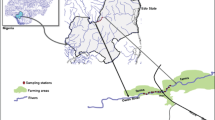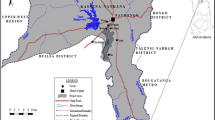Abstract
This study aims to determine the distribution of organochlorine pesticide pollution in water, sediments, mollusks, and fish at Saguling Dam as baseline data of organochlorine pollution. Samples were obtained from 12 locations, with 9 and 3 sampling points inside and outside the dam, respectively. Measurement of organochlorine residues was carried out using methods of extraction, purification, evaporation, and gas chromatography. Results showed the presence of several types of organochlorine compounds, namely, lindane, aldrin, dieldrin, heptachlor, dichlorodiphenyltrichloroethane (DDT), and endosulfan. Aldrin was dominant in water (2–37 μg/L) and sediments (2–1438 μg/L), while DDT and heptachlor were dominant organochlorine compounds in mollusks (13–2758 µg/L) and fish (11–104 μg/L), respectively. Sediments demonstrated higher organochlorine concentrations than water, mollusk, and fish. The distribution of organochlorine was affected by land use around the Citarum watershed and pollutant input from tributaries.






Similar content being viewed by others
References
Chopra AK, Sharma MK, Chamoli S (2011) Bioaccumulation of organochlorine pesticides in aquatic system—an overview. Environ Monit Assess 173:905–916. https://doi.org/10.1007/s10661-010-1433-4
Yang RQ, Jiang GB, Zhou QF, Yuan CG, Shi JB (2005) Occurrence and distribution of organochlorine pesticides (HCH and DDT) in sediments collected from East China Sea. Environ Int 31:799–804. https://doi.org/10.1007/s10661-009-1131-2
Ensley SM (2018) Organochlorines. In: Veterinary toxicology. Academic Press, pp 509–513
Blanco-Muñoz J, Lacasaña M, López-Flores I, Rodríguez-Barranco M, González-Alzaga B, Bassol S et al (2016) Association between organochlorine pesticide exposure and thyroid hormones in floriculture workers. Environ Res 150:357–363. https://doi.org/10.1016/j.envres.2016.05.054
Ogbeide O, Tongo I, Ezemonye L (2015) Risk assessment of agricultural pesticides in water, sediment, and fish from Owan River, Edo State, Nigeria. Environ Monitor Assess 187:654. https://doi.org/10.1007/s10661-015-4840-8
Damalas CA, Eleftherohorinos IG (2011) Pesticide exposure, safety issues, and risk assessment indicators. Int J Environ Res Public Health 8:1402–1419. https://doi.org/10.3390/ijerph8051402
Hasan HA, Muhammad MH (2020) A review of biological drinking water treatment technologies for contaminants removal from polluted water resources. J Water Process Eng 33:101035. https://doi.org/10.1016/j.jwpe.2019.101035
Damalas CA, Koutroubas SD (2016) Farmers’ exposure to pesticides: toxicity types and ways of prevention. https://doi.org/10.3390/toxics4010001
Kim SH, Jang JB, Park KH, Paik MK, Jeong SH (2016) Evaluation of dermal absorption rate of pesticide chlorpyrifos using in vitro rat dermal tissue model and its health risk assessment. Biomed Sci Lett 22:140–149. https://doi.org/10.15616/BSL.2016.22.4.140
Oginawati K, Sidhi R, Susetyo SH (2020) Lead exposure in trader communities in industrial area of the battery recycling plant: Tangerang, Indonesia. J Ecol Eng. https://doi.org/10.12911/22998993/118297
Uwizeyimana H, Wang M, Chen W, Khan K (2017) The eco-toxic effects of pesticide and heavy metal mixtures towards earthworms in soil. Environ Toxicol Pharmacol 55:20–29. https://doi.org/10.1016/j.etap.2017.08.001
Sherwood SG, Paredes M (2014) Dynamics of perpetuation: the politics of keeping highly toxic pesticides on the market in Ecuador. Nat Culture 9:21–44. https://doi.org/10.3167/nc.2014.090102
Eka W, Suprihanto N, Dwina R (2018) Assessment of heavy metal contamination in Saguling dam water West Java Province Indonesia. In: E3S Web of Conferences, Vol. 73. EDP Sciences, p 06009. https://doi.org/10.1051/e3sconf/20187306009
Marselina M, Sabar A, Salami IR, Marganingrum D (2016) Management optimization of Saguling dam with bellman dynamic programming and “Du Couloir” iterative method. Forum Geografi 30:14–23. https://doi.org/10.23917/forgeo.v30i1.1682
Tanjung RHR, Hamuna B, Yonas MN (2019) Assessing heavy metal contamination in marine sediments around the coastal waters of Mimika Regency, Indonesia. J Ecol Eng 20:35–42. https://doi.org/10.12911/22998993/113411
Yang C, Li Y, Zha D, Lu G, Sun Q, Wu D (2017) A passive sampling method for assessing the occurrence and risk of organophosphate flame retardants in aquatic environments. Chemosphere 167:1–9. https://doi.org/10.1016/j.chemosphere.2016.09.141
Novic AJ, O’Brien DS, Kaserzon SL, Hawker DW, Lewis SE, Mueller JF (2017) Monitoring herbicide concentrations and loads during a flood event: a comparison of grab sampling with passive sampling. Environ Sci Technol 51:3880–3891. https://doi.org/10.1021/acs.est.6b02858
Mehdinia A, Ramezani M, Jabbari A (2017) Preconcentration and determination of lead ions in fish and mollusk tissues by nanocomposite of Fe3O4@ graphene oxide@ polyimide as a solid phase extraction sorbent. Food Chem 237:1112–1117. https://doi.org/10.1016/j.foodchem.2017.06.051
Tagliavia M, Nicosia A, Salamone M, Biondo G, Bennici CD, Mazzola S, Cuttitta A (2016) Development of a fast DNA extraction method for sea food and marine species identification. Food Chem 203:375–378. https://doi.org/10.1016/j.foodchem.2016.02.095
Kuranchie-Mensah H, Atiemo SM, Palm LMND, Blankson-Arthur S, Tutu AO, Fosu P (2012) Determination of organochlorine pesticide residue in sediment and water from the Densu river basin. Ghana Chemosphere 86:286–292. https://doi.org/10.1016/j.chemosphere.2011.10.031
Yang YY, Toor GS, Williams CF (2015) Pharmaceuticals and organochlorine pesticides in sediments of an urban river in Florida, USA. J Soils Sediments 15:993–1004. https://doi.org/10.1007/s11368-015-1077-7
Ren X, Pan L, Wang L (2014) Metabolic enzyme activities, metabolism-related genes expression and bioaccumulation in juvenile white shrimp Litopenaeus vannamei exposed to benzo [a] pyrene. Ecotoxicol Environ Saf 104:79–86. https://doi.org/10.1016/j.ecoenv.2014.02.016
Geng D, Jogsten IE, Dunstan J, Hagberg J, Wang T, Ruzzin J et al (2016) Gas chromatography/atmospheric pressure chemical ionization/mass spectrometry for the analysis of organochlorine pesticides and polychlorinated biphenyls in human serum. J Chromatogr A 1453:88–98. https://doi.org/10.1016/j.chroma.2016.05.030
Kabir MH, El-Aty AA, Im SJ, Rahman MM, Kim SW, Farha W et al (2016) Determination of residual levels of metrafenone in lettuce grown under greenhouse conditions using gas chromatography with a micro-electron capture detector. Appl Biol Chem 59:43–49. https://doi.org/10.1007/s13765-015-0126-7
Farina Y, Abdullah MP, Bibi N, Khalik WMAWM (2017) Determination of pesticide residues in leafy vegetables at parts per billion levels by a chemometric study using GC-ECD in Cameron Highlands, Malaysia. Food Chem 224:55–61. https://doi.org/10.1016/j.foodchem.2016.11.113
Chaiyarat R, Sookjam C, Eiam-Ampai K, Damrongphol P (2015) Organochlorine pesticide levels in the food web in rice paddies of Bueng Boraphet wetland, Thailand. Environ Monitor Assess 187:230
Bethesda MD (1995) US National Library of Medicine. Hazardous Substances DataBank, pp 6–18
Rani M, Shanker U, Jassal V (2017) Recent strategies for removal and degradation of persistent and toxic organochlorine pesticides using nanoparticles: a review. J Environ Manage 190:208–222
Schäfer S, Buchmeier G, Claus E, Duester L, Heininger P, Körner A et al (2015) Bioaccumulation in aquatic systems: methodological approaches, monitoring and assessment. Environ Sci Eur 27:5. https://doi.org/10.1186/s12302-014-0036-z
Oginawati K, Pratama MA (2016) Identification and level of organochlorine insecticide contamination in groundwater and iridology analysis for people in Upper Citarum cascade. J Phys Conf Ser 694(1):012078. https://doi.org/10.1088/1742-6596/694/1/012078
Oginawati K, Susetyo SH, Rosalyn FA et al (2020) Risk analysis of inhaled hexavalent chromium (Cr6+) exposure on blacksmiths from industrial area. Environ Sci Pollut Res. https://doi.org/10.1007/s11356-020-11590-6
Republic of Indonesia Government Regulation (2001) Concerning Water Quality Management and Water Pollution Control, no. 82
Rahaman MM, Islam KS, Jahan M (2018) Rice farmers’ knowledge of the risks of pesticide use in Bangladesh. J Health Pollut 8:181203. https://doi.org/10.5696/2156-9614-8.20.181203
Osman BE, Khalik WMAWM (2018) Data on organochlorine concentration levels in soil of lowland paddy field, Kelantan, Malaysia. Data Brief 20:999–1003. https://doi.org/10.1016/j.dib.2018.08.178
Chang GR (2018) Persistent organochlorine pesticides in aquatic environments and fishes in Taiwan and their risk assessment. Environ Sci Pollut Res 25:7699–7708. https://doi.org/10.1007/s11356-017-1110-z
Kafilzadeh F (2015) Assessment of organochlorine pesticide residues in water, sediments and fish from Lake Tashk, Iran. Achiev Life Sci 9:107–111. https://doi.org/10.1016/j.als.2015.12.003
Abdallah MAM, Elmagd Morsy FA (2013) Persistent organochlorine pollutants and metals residues in sediment and freshwater fish species cultured in a shallow lagoon. Egypt Environ Technol 34:2389–2399. https://doi.org/10.1080/09593330.2013.770561
United States Environmental Protection Agency (US EPA) (2003) Health effects support document for Aldrin/Dieldrin. United States Environmental Protection Agency
Nguyen TX, Nguyen BT, Tran HTT, Mai H, Duong TT, Bach QV (2019) Seasonal, spatial variation, and potential sources of organochlorine pesticides in water and sediment in the lower reaches of the Dong Nai river system in Vietnam. Arch Environ Contam Toxicol 77:514–526. https://doi.org/10.1007/s00244-019-00653-6
Syasina IG (2003) Organochlorine pesticides in fishes and mollusks from lower reaches of the Tumen River and of the contiguous part of Peter the Great Bay (Sea of Japan). Russian J Mar Biol 29:23–30. https://doi.org/10.1023/A:1022871703034
Codex Alimentarius Commission, Joint FAO/WHO Food Standards Programme & World Health Organization (2007) Codex alimentarius commission: procedural manual. Food & Agriculture Org
Gerber R, Smit NJ, Van Vuren JH, Nakayama SM, Yohannes YB, Ikenaka Y et al (2016) Bioaccumulation and human health risk assessment of DDT and other organochlorine pesticides in an apex aquatic predator from a premier conservation area. Sci Total Environ 550:522–533. https://doi.org/10.1016/j.scitotenv.2016.01.129
Jacomini AE, de Camargo PB, Avelar WEP, Bonato PS (2011) Assessment of ametryn contamination in river water, river sediment, and mollusk bivalves in São Paulo State, Brazil. Arch Environ Contam Toxicol 60:452–461
Voa Indonesia (2019) Upaya Indonesia Bersihkan Sungai Terkotor di Dunia. https://www.voaindonesia.com/a/upaya-indonesia-bersihkan-sungai-terkotor-di-dunia-(1)/4745640.html. Accessed 25 Dec 2020
Acknowledgements
The authors would like to thank all team members, especially the research group of Environmental Management Technology of Institut Teknologi Bandung. The authors are also grateful to the Ministry of Higher Education Malaysia and Universiti Kebangsaan Malaysia for supporting this study under the research grant DCP-2018-006/3.
Author information
Authors and Affiliations
Corresponding author
Ethics declarations
Conflict of interest
The authors hereby declare no conflict of interest regarding the publication of this work.
Rights and permissions
About this article
Cite this article
Oginawati, K., Susetyo, S.H., Rahmawati, S.I. et al. Distribution of organochlorine pesticide pollution in water, sediment, mollusk, and fish at Saguling Dam, West Java, Indonesia. Toxicol Res. 38, 149–157 (2022). https://doi.org/10.1007/s43188-021-00094-1
Received:
Revised:
Accepted:
Published:
Issue Date:
DOI: https://doi.org/10.1007/s43188-021-00094-1




